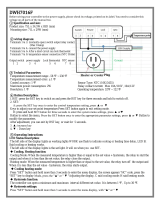600
CONTROLLER
SOFTWARE VERSION 4.0x
code 80336L / Edition 15 - 07/2011
USER’S MANUAL
1 • INSTALLATION
• Dimensions and cut-out; panel mounting
Panel mounting:
To fix the unit, insert the brackets provided into the seats on either side of the case.
To mount two or more units side by side, respect the cut-out dimensions shown in the drawing.
CE MARKING: The instrument conforms to the European Directives 2004/108/CE and
2006/95/CE with reference to the generic standards: EN 61000-6-2 (immunity in industrial
environment) EN 61000-6-3 (emission in residential environment) EN 61010-1 (safety).
MAINTENANCE: Repairs must be done only by trained and specialized personnel.
Cut power to the device before accessing internal parts.
Do not clean the case with hydrocarbon-based solvents (Petrol, Trichlorethylene, etc.). Use of
these solvents can reduce the mechanical reliability of the device. Use a cloth dampened in
ethyl alcohol or water to clean the external plastic case.
SERVICE: GEFRAN has a service department. The warranty excludes defects caused by any
use not conforming to these instructions.
99
10
45
45
48
70
70
63
48
FUNCTION CABLE TYPE LENGTH
Power supply cable 1 mm
2
1 m
Relay output cable 1 mm
2
3,5 m
Digital communication wire 0,35 mm
2
3,5 m
C.T. connection cable 1,5 mm
2
3,5 m
TC input 0,8 mm
2
compensated 5 m
Pt100 input 1 mm
2
3 m
EMC conformity has been tested with the following connections
For correct and safe installation, follow
the instructions and observe the warnings
contained in this manual.
!
Logic inputs Ri = 4,7KΩ (24V, 5mA) or no-voltage contact
Protocol Gefran CENCAL / MODBUS
Serial interface (optional) RS485, isolated
Analogue retransmission signal
0...10V Rload ≥ 250KΩ, 0/4...20mA Rload ≤ 500Ω
resolution 12 bit
Transmitter power supply 15/24Vdc, max 30mA short-circuit protection
Type of relay contact NO (NC), 5A, 250V/30Vdc cosϕ=1
Logic output for static relays 24V ±10% (10V min at 20mA)
Cycle time 0...200 sec
Main output type
relay, logic, continuous (0...10V Rload ≥ 250KΩ,
0/4...20mA Rload ≤ 500Ω)
Control outputs on / off, continuous
Maximum power limit heat / cool 0,0...100,0 %
°C / °F selection configurable from faceplate
Linear scale ranges -1999 to 9999 with configurable decimal point position
Controls PID, Self-tuning, on-off
pb - dt - it 0,0...999,9 % - 0,00...99,99 min - 0,00...99,99 min
Action Heat / Cool
Softstart 0,0...500,0 min
Configurable alarms
Up to 3 alarm functions assignable to an output,
configurable as: maximum, minimum, symmetrical,
absolute/deviation, LBA, HB
Fault power setting -100,0...100,0 %
Automatic blanking Displays PV value, optional exclusion
Alarm masking
- exclusion during warm up
- latching reset from faceplate or external contact
Optional ammeter input T.A. 50mAac, 50/60Hz, Ri = 10Ω
Faceplate protection IP65
Working / Storage temperature range 0...50°C / -20...70°C
Relative humidity 20 ... 85% non-condensing
Installation Panel, plug-in from front
Weight 160g for the complete version
Power supply (switching type)
(std) 100 ... 240Vac ±10%
(opt.) 11...27Vac/dc ±10%;
50/60Hz, 8VA max
Safety
detection of short-circuit or opening of probes,
LBA alarm, HB alarm
RTD type (scale configurable within indicated
range, with or without decimal point)
(ITS90)
Max line resistance for RTD
DIN 43760 (Pt100), JPT100
20Ω
Cold junction error
0,1° / °C
PTC type / NTC Type 990Ω, 25°C / 1KΩ, 25°C
Type TC Thermocouples
(ITS90)
Display 2x4 digit green, high display 10 and 7mm
Keys 4 of mechanical type (Man/Aut, INC, DEC, F)
Accuracy 0.2% f.s. ±1 digit ambient temperature 25°C
Main input (settable digital filter)
TC, RTD, PTC, NTC
60mV,1V Ri≥1MΩ; 5V,10V Ri≥10KΩ; 20mA Ri=50Ω
Tempo di campionamento 120 msec.
2 • TECHNICAL SPECIFICATIONS
Type TC Thermocouples : J,K,R,S,T (IEC 584-1,
CEI EN 60584-1, 60584-2) ; custom linearization
is available / types B,E,N,L GOST,U,G,D,C are
available by using the custom linearization.
Triac output
20...240Vac ±10%, 1A max
Snubberless, inductive and resistive load I
2
t = 128A
2
s
Baude rate 1200, 2400, 4800, 9600, 19200
Environmental conditions of use for internal use only, altitude up to 2000m
Digital Insulated Output
optoinsulated MOS output 1500V






















